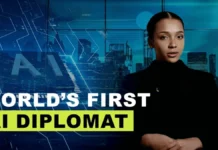Traditionally, MFAs (ministries of foreign affairs) have been viewed as organizations that face the world with their back to the nation as they have been responsible for communicating with foreign populations rather than the national citizenry. Thus, unlike ministries of Justice, Homeland Security and Culture, MFAs were never able to foster a domestic constituency putting them at a disadvantage when compared with their peers. The rapid process of globalization has further eroded MFAs’ standing within governments. Given that global challenges require global solutions, a growing number of government ministries (e.g., health, energy, justice) now also face the world and collaborate with their equivalents overseas. Subsequently, MFAs have lost their monopoly on external ties and lost territory within governments.
Yet the global proliferation of ICTs and digital technologies has enabled MFAs to interact directly with their citizens and provide them with an array of services thus developing a domestic constituency. This is nowhere more evident than in the realm of consular aid.
The State of the Art
To date, the delivery of digital consular aid has taken two forms. First, several MFAs have launched consular applications. These applications can be used by citizens travelling abroad to gather relevant information on their destination, receive travel warnings in near real-time and even communicate with nearby Embassies should the need arise. The Polish consular application, for instance, enables citizens to send out SOS signals when in need of emergency aid.

Second, MFAs and Embassies have taken to using social media in order to contact citizens during a consular crisis. For instance, following the 2014 Nepal earthquake both the Canadian and US MFAs took to twitter in order to provide citizens with emergency contact information such as telephone numbers and email addresses (see example below).

However, the aforementioned tweet by the State Department serves to illustrate three limitations of digital consular aid. First, it was assumed that US citizens in Nepal would see this tweet. Yet the chances of that happening were quite slim given social media algorithms that filter information. Twitter users who were likely to see the State Department’s tweet were those who actively follow the Department or who have expressed an interest in US diplomacy, US diplomats or US foreign policy. In other words, most of the Americans in need of aid in Nepal would have never seen the emergency contact information. Second, even if Twitter users did see this tweet, it is unlikely that they could contact the Embassy as cellular infrastructure is among the first victims of any consular crisis be it a terrorist attack, hurricane or earthquake. Finally, it is unlikely that twitter users would have written an email to the State Department. Most would have simply replied to the tweet in real time or tweeted questions at the Embassy.
In other words, emergency Tweets such as the ones formulated after the Nepal earthquake may fail to obtain consular objectives. Meeting such objectives requires moving beyond the state of the art.
Beyond the State of the Art
During a consular crisis, an Embassy must perform three key functions- gather information, disseminate information and provide aid to citizens.
The first challenge arises from the fact that during crises, platforms such as Twitter become swamped with misinformation, rumors and half-truths. The Embassy is thus required to drown out the noise and focus on gathering reliable information. One way to do so is to create a dedicated Twitter account for consular emergencies. Such an account, which is used solely for information gathering, should follow other Embassies who are likely to publish reliable information, the local MFA, local crisis centers (such as the one established by the Belgian government), municipal accounts, local and national police authorities and trusted news agencies, newspaper and journalists. It is through such an account that an Embassy can drown out the noise on Twitter and instead focus on a steady stream of reliable information being published in real time.

Second, the Embassy may begin to search networks such as Twitter using trending hashtags. Hashtags are a way of organizing information online. Moreover, hashtags always emerge in the hours following a consular event whether they originate from the media, online users or the local authorities. One way to identify trending hashtags is to use applications such as TweetDeck (see below), an application that enables a social media user to instantly view all his contacts on a large canvas. An Embassy, which has activated the emergency Twitter account mentioned above, may turn to TweetDeck and monitor all the Tweets being published by trusted sources. Soon a trending hashtag will emerge. Next, the Embassy can search that hashtag in TweetDeck thus creating a new stream of Tweets all bearing the relevant hashtag. In this manner, an Embassy may be able to identify additional sources of reliable information.

Third, an Embassy should rate the accuracy of the accounts it follows online. Police and security forces are the most cautious during a crisis and are unlikely to publish information before it has been verified. Media organizations are less cautious and, given their need to compete with citizen journalists and bloggers, they publish information which at times is less accurate. Finally, independent users and citizen journalists can supply real-time information but also tend to publish rumors and half-truths. However, an Embassy may choose to follow independent news sources while not disseminating any information until it has been verified by a more credible source such as the media or local police. The reason for doing so is that it enables the Embassy to anticipate citizens’ possible needs or challenges that may arise internally. In other words, independent sources offer a possible glimpse into the future.
Lastly, the Embassy must have a dedicated staffer who is tasked with monitoring social media accounts during a crisis and synthesizing all information for the Embassy leadership. It is preferable that the staffer gathering information be a digital native and a local employee. Digital natives excel at multi-tasking, gathering information from multiple digital sources and identifying online trends. As such, they offer immense added values during a crisis. Local employees may be better suited to identify trusted sources of information during a crisis.
Once the Embassy has gathered information, it must also disseminate information. Yet this requires that Embassies hack algorithms so as to reach the largest possible audience. One way of doing so is “piggybacking” on trending hashtags. By using trending hashtags an Embassy can increase the likelihood of its content being seen and shared by users trying to learn about unfolding events. Second, the Embassy can ask its followers to help disseminate information thus exponentially increasing its reach and the diversity of audiences it can interact with. This is exactly what the Canadian MFA did during the Nepal earthquake. As can be seen in the Tweet below, the MFA incorporated a trending hashtag (NeaplQuake) and directly asked follower to “Please Re Tweet”.

In addition, Embassies should adopt a networked approach to online crisis communication. For instance, the Israeli Embassy in London (see below) is a member of a myriad of online networks. One such network consists of Israeli governmental institutions as the Israeli Embassy follows, and is followed by, the Prime Minister’s office, the MFA and Ministry of Defense. In addition, the Israeli Embassy is part of the global network of Israeli Embassies as well as the network of foreign Embassies operating in London. Finally, the Israeli Embassy is part of its own network that includes Jewish journalists and media organizations, Diaspora organizations and Israeli expats. If all these networks re-tweet the Embassy’s content they will dramatically increase its reach, the diversity of audiences it reaches and the Embassy’s ability to interact with citizens in need of assistance.

Another important element of digital consular diplomacy is media relations. Once a consular event takes place people are likely to turn to news sites for information. However, tourists are likely to visit news sites in their home country and not the country they are visiting. In other words, Canadians in London are likely to check Canadian websites following an event and not British news sites. As such, Embassies should be able to contact popular news organizations in their home country and ask these organizations to share Embassy content online and to include the Embassy’s emergency information in all news stories they publish. This way, citizens in need of aid will be able to get in contact with the local Embassy.
Finally, Embassies require a dedicated staffer who interacts online with citizens requiring aid or seeking information. That is exactly what the Kenyan MFA did once fighting broke out in South Sudan in 2013. Over a period of several days, Kenyan diplomats manned computers and interacted with Kenyan citizens on Twitter while offering information, advice and remote assistance. The MFA even used Twitter to evacuate citizens through emergency flights.
Managing a Crisis
Importantly, digital tools may also be used by the Embassy leadership. As Corneliu Bjola has written, Embassies can create WhatsApp groups that include the Ambassador, the consular officer, the press secretary, staffers gathering information online, diplomats from headquarters and staffers answering citizens’ queries online. This group can function as a crisis management cell enabling real-time information gathering, decision making and information dissemination.
Yet above all, Embassies must prepare in advance if they wish to use digital tools during a consular crisis. Staffers need to be familiar with dedicated Twitter accounts and TweetDeck. WhatsApp groups need to be tried and tested as some diplomats may be unfamiliar with the application while the press secretary must have the contact details of news sites and journalists in his home country. One way to ensure Embassy readiness is to conduct digital simulations. Such simulations will be the topic of my next blog post.













